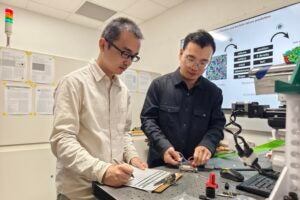Texas Gov. Greg Abbott has called for the elimination of the Emerging Technology Fund, a program that gave $200 million in taxpayer dollars to Texas startups but was hindered by bankruptcies and other issues.
This may be a reasonable decision. After all, when programs are not cost effective, they need to be changed or eliminated.
But this should not be the last decision. We have the opportunity and a responsibility to make Texas more successful in the 21st century than it was in the 20th.
One part of the Emerging Technology Fund was dedicated to getting a larger piece of the economic pie for Texas at the expense of other states. The other was focused to growing the economic pie in Texas.
It is self-evident that attracting established companies is an effort to grow at the expense of other states. Attracting researchers is similar in that there is a finite national investment in research by the federal government and industry.
More researchers attract a larger share of those funds to Texas. This has a demonstrated benefit as each dollar of research funding grows the economy by about 2½ dollars.
Growing the economic pie is even more important. As a colleague of mine is fond of saying, “Research turns money into knowledge. Innovation turns knowledge into money.” Between the research and the innovation, however, is something called “the technology valley of death.”
Governments typically move technology across the valley of death. Technologies as diverse as railroads, the Internet, nanotechnology and pharmaceuticals received critical government support, as did the core technologies of the iPhone. Once the technology gets across the valley of death, amazing things can happen.
If Texas dropped out of the activity, the state would depend on federal government investments to develop these technologies in Texas. Unfortunately, the federal government increasingly invests where the host state is willing to invest.
If Texas opts out, innovation will occur elsewhere. We will have the research. Others will have the climate of innovation that turns knowledge into economic growth.
But there are characteristics that a state program should have. First, it should be run by professionals who are employees of Texas. The state’s retirement system is a good model. Texas hires portfolio managers to make investment choices.
Elected officials review the long-term results. They do not approve every purchase and sale. The same should be true in developing longer-term technologies. Hire professionals and hold them responsible for the success of the portfolio.
Second, there are critical aspects to successful projects, and they should each be assessed by experts. One is that the quality and potential growth of the technology. These should be evaluated by technology experts. They could be drawn from researchers at Texas universities as many of these are among the best in the world in their fields.
They should sort proposals so that only those that transfer research results into interesting technology should go forward. To do otherwise is to compete in the marketplace not to get technologies across the valley of death.
Those passing technical scrutiny should then be reviewed by a business group. The group would determine that, if successful, the proposed project can be a marketable product. The program managers then select the final portfolio from among projects that easily pass both hurdles.
Finally, the impact of the portfolio needs to be measured. Independent economists should routinely and independently assess the success of the portfolio. Based on other programs, the portfolio should deliver $4 to $5 for every dollar invested within the first few years, and the return should continue to grow.
This program is an investment in our future, and it must pay off.
Gov. Abbott is providing a golden opportunity to try again to develop a technology-based economic develop program that works for Texas. It is an opportunity we cannot afford to waste.
Robert Hebner is the director of the Center for Electromechanics at The University of Texas at Austin and formerly served as acting director of the National Institute of Standards and Technology, an agency of the U.S. Department of Commerce.
A version of this op-ed appeared in the San Antonio Express News, Fort Worth Star Telegram, Austin American Statesman, Beaumont Enterprise, Houston Chronicle, The McAllen Monitor and the Corpus Christi Caller Times.
Related op-ed on Texas Perspectives:
Now Is The Time To Put A Tax On Carbon
What the Paris Attack Can Teach Us about Freedom of Expression
We May Finally Get a Senate Worthy of Being Called “Great”
To view more op-eds from Texas Perspectives, click here.
Like us on Facebook.
Share this story on Twitter:
Texas Gov. Greg Abbott has called for the elimination of the Emerging Technology Fund. Good idea? Expert weighs in. http://t.co/dSqyVECCNH
— Texas Perspectives (@TexPerspectives) February 4, 2015



